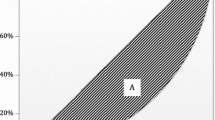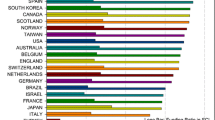Abstract
Scientific research activity produces the “Matthew Effect” on resource allocation. Based on a data set in the life sciences field from the National Natural Science Foundation of China (NSFC) during the 11th Five-Year-Plan (2006–2010), this paper makes an empirical study on how the Matthew Effect of funding allocation at the institutional level and city level impact scientific research activity output. With Gini coefficient evaluation, descriptive statistic analysis, and the Poisson regression model, we found that there has been a rapid increase in the concentration degree of funding allocation among institutions and cities. Within a period of 5 years, the Gini coefficients of total funding of institutions and cities as the units of measurement have increased from 0.61 and 0.74 to 0.67 and 0.79 respectively. However, this concentration in funding allocation did not result in significant additional benefits. Institutions awarded with more funding did not produce the expected positive spillover effect on their scientific research activity output. Instead, an “inverted U-shape” pattern of decreasing returns to scale was discovered, under which there was a negative effect on internal scientific research activity in the majority of institutions with concentrated funding allocation. Meanwhile, the result shows that Young Scholars projects under the NFSC produced high-level output. We conclude the study by discussing the possible reasons of the inverted U-shape pattern and its policy implications.





Similar content being viewed by others
Notes
The Gini coefficient is widely used for measuring the inequality (Haughton and Haughton 2011) as it evaluates public policy from the aspect of social welfare. The Gini coefficient is relevant to the Lorenz curve, which reflects the rate between the area of the absolute equity line (the diagonal line) to the Lorenz curve and the triangle area under the diagonal line. The data is calculated by the author based on the NSFC database created from data in the life sciences field.
The data is based on the NSFC database for the life sciences field from 2006 to 2010.
Life sciences have always received the most governmental support. In 2010, NSFC established the medical sciences field, separating medical science from life science. The data used in this research is according to the adjusted definition of the life sciences field, which includes 20 subjects: C01 microbiology, C02 botany, C03 ecology, C04 zoology, C05 biophysics, biochemistry and molecular biology, C06 genetics and information biology, C07 cryobiology, C08 immunology, C09 neurocognitive and psychology, C10 bio-mechanic and organizational engineering, C11 physiology and integrative biology, C12 developmental biology and reproductive biology, C13 agronomy and crop science, C14 plant protection, C15 horticultural and plant nutrition, C16 forestry, C17 zoology and grassland science, C18 veterinary medicine, C19 fisheries science, and C20 bromatology.
Considering the initiation year of the project, we used the 2010 SCI journal impact scores from Thomson Reuters.
In the panel data analysis based on the Poisson regression model and FE model, English papers is the dependent variable, and institution funding and city funding are independent variables; the size of institutions and cities do not change much, and so were not included in the regression model. For the Poisson regression based on English papers, the regression coefficient of institutions is 1.710, while its quadratic term coefficient is −0.083; meanwhile, if the dependent variable is Chinese papers, the coefficient of institution is 1.681, while its quadratic term coefficient is −0.062. Coefficients are significant at 1 %.
The Poisson regression coefficient of city funding is 0.116 and it is significant at 1 %.
References
Arora, A., & Gambardella, A. (1996). Reputation and competence in publicly funded scientific research (No. 9605002). EconWPA.
Arora, A., & Gambardella, A. (1997). Public policy towards science: Picking stars or spreading the wealth? Revue D Économie Industrielle, 79(1), 63–75.
Blank, D. M., & Stigler, G. J. (1957). The demand and supply of scientific personnel. Cambridge: NBER Books, National Bureau of Economic Research, General Series.
Bloch, C., & Sørensen, M. P. (2014). The size of research funding: Trends and implications. Science and Public Policy, 42(1), 30–43.
Cameron, A. C., & Pravin, K. T. (1998). Regression analysis of count data. New York: Cambridge University Press.
Cowell, F. A. (2000). Measurement of inequality. Handbook of Income Distribution, 1, 87–166.
Freeman, R. B. (1975). Supply and salary adjustments to the changing science manpower market: Physics, 1948–1973. The American Economic Review, 65(1), 27–39.
Halffman, W., & Leydesdorff, L. (2010). Is inequality among universities increasing? Gini coefficients and the elusive rise of elite universities. Minerva, 48(1), 55–72.
Haughton, D., & Haughton, J. (2011). Living standards analytics: Development through the lens of household survey data. Berlin: Springer.
He, G., Zhao, Y., & Yang, Q. (2014). Inequality in allocation of R&D resources in China: An analysis on the concentration of R&D funds among Chinese researchers. China Soft Science, 2014(6), 58–66. (in Chinese).
Jaffe, A. B. (1989). Real effects of academic research. The American Economic Review, 79(5), 957–970.
Kenneth, A. J., & Capron, W. M. (1959). Dynamic shortages and price rises: The engineer-scientist case. Quarterly Journal of Economics, 73(2), 292–308.
Levin, S. G., & Stephan, P. E. (1991). Research productivity over the life cycle: Evidence for academic scientists. The American Economic Review, 81(1), 114–132.
Li, X., & Zhou, Z. (2014). Should research funds be means or purpose? Science and Society, 2014(3), 29–35. (in Chinese).
Long, J. S., & Freese, J. (2006). Regression models for categorical dependent variables using Stata. College Station: Stata Press.
Merton, R. K. (1968). The Matthew effect in science. Science, 159(3810), 56–63.
Merton, R. K. (1988). The Matthew effect in science, II: Cumulative advantage and the symbolism of intellectual property. Isis, 79(3), 606–623.
Merton, R. K., & Sztompka, P. (Eds.). (1996). On social structure and science. Chicago: University of Chicago Press.
Nelson, R. R. (1959). The simple economics of basic scientific research. Journal of Political Economy, 67(3), 297–306.
NSF. (2014). Science and engineering indicators 2014, Chapter 5.
NSFC. (2011). Annual report of National Natural Science Foundation of China 2011. http://www.nsfc.gov.cn/nsfc/cen/ndbg/2011ndbg/index.html
Partha, D., & David, P. A. (1994). Toward a new economics of science. Research Policy, 23(5), 487–521.
Price, D. D. S. (1963). Big science, little science (pp. 119–119). New York: Columbia University.
Rosenberg, N. (1986). Inside the black box: Technology and economics. Boston: Cambridge University Press.
Shen, H. F., Liao, X. Y., Chen, J. F., & Wang, L. (2008). A study on the disequilibrium of agriculture science research investment—Calculation and decomposition of Gini coefficient of agriculture science research investment. Soft Science, 12, 012. (in Chinese).
Si, K. (2014). “Unequal” view of science, Issue 7. World Science. (in Chinese).
Statistical Yearbook of China. (2013–2014). http://www.stats.gov.cn/tjsj/ndsj/2013/indexeh.htm
Stephan, P. E. (1996). The economics of science. Journal of Economic Literature, 34(3), 1199–1235.
Stephan, P. E. (2012). How economics shapes science. Cambridge, MA: Harvard University Press.
Stephan, P. E., & Levin, S. G. (1992). Striking the mother lode in science: The importance of age, place, and time. USA: Oxford University Press.
Sun, J., Liu, D., Wang, X., & Hou, H. (2013). Science funding and SCI papers output: A comparative analysis on 10 countries. Studies in Science of Science, 31(1), 36–42. (in Chinese).
Van Looy, B., Ranga, M., & Callaert, J. (2004). Combining entrepreneurial and scientific performance in academia: Towards a compounded and reciprocal Matthew-effect? Research Policy, 33(3), 425–441.
Wang, Y., Wu, Y., Pan, Y., Ma, Z., & Rousseau, R. (2005). Scientific collaboration in China as reflected in co-authorship. Scientometrics, 62(2), 183–198.
World Development Indicators. (2014). Research and development expenditure. http://data.worldbank.org/data-catalog/world-development-indicators/
Wooldridge, J. (2012). Introductory econometrics: A modern approach. Cengage Learning.
Wu, Jiang. (2015). Distributions of scientific funding across universities and research disciplines. Journal of Informetrics, 9, 183–196.
Wu, Y., & Su, J. (2011). Basic research funding and the research output: 1991–2008. Study of Higher Education, 11, 03. (in Chinese).
Xie, Yu. (2014). Undemocracy”: Inequalities in science. Science, 344, 809–810.
Xue, B., Li, M., & Wang, S. (2004). A comparison between Chinese and American governments in financing the scientific research in higher educational institutes. Tsinghua Journal of Education, 25(6), 54–59. (in Chinese).
Yu, J., Tong, H., Huang, M., & Chen, D. (2012). Imbalanced phenomenon of regional research output in Mainland China: Comparison from the angle of ESI. Science and Technology Management Research, 12, 019.
Zhang, J. (2011). Peer review in American higher education peer review. China Higher Education Research, 2011(10), 40–42. (in Chinese).
Zheng, M. A., Zheng-lu, Y. U., Jun-peng, Y. U. A. N., Cheng, S. U., Zhi-yu, H. U., Yun-tao, P. A. N., et al. (2009). Using Gini coefficient to reflect the inequality degree of S&T publications in China and other countries. Studies in Science of Science, 3, 006. (in Chinese).
Zhi, Q., Su, J., Ru, P., & Anadon, L. D. (2013). The evolution of China’s National Energy RD&D Programs: The role of scientists in science and technology decision making. Energy Policy, 61, 1568–1585.
Zhu, L. (2013). Matthew effect in Germany excellent program. Journal of Heilongjiang College of Education, 2013(5), 176–177. (in Chinese).
Acknowledgments
This paper is supported by the National Natural Science Foundation of China (No: 71503291 and No: L1524030), General research for Humanities and Social Sciences from Chinese Ministry of Education (Grant Number: 14YJC630209), and the 121 Talent Projects for Young Doctors of Central University of Finance and Economics (Grant Number: QBJ1430). We wish to thank Ming Lu, Xiangtao Zhou, Ying Yang, Xinyi Zhu, Yanran Geye and Jipeng Fei for their valuable suggestions and support regarding our work. We also appreciate the valuable comments of the two anonymous reviewers. All remaining errors remain the sole responsibility of the authors.
Author information
Authors and Affiliations
Corresponding author
Rights and permissions
About this article
Cite this article
Zhi, Q., Meng, T. Funding allocation, inequality, and scientific research output: an empirical study based on the life science sector of Natural Science Foundation of China. Scientometrics 106, 603–628 (2016). https://doi.org/10.1007/s11192-015-1773-5
Received:
Published:
Issue Date:
DOI: https://doi.org/10.1007/s11192-015-1773-5




